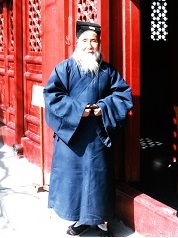Daoist Sage (1880–1988) – Complete Reality School

I met him in 1985. He was 105 years old with a long white beard. Mostly he sat quietly inside the main temple building where trainee monks would regularly come for chanting, summoned by the ringing of a bell.
The old sage Master Du, was quiet but observant and wishing to communicate with him we waited patiently in front of him. After about 5 minutes of studying us he began to talk and once begun he continued non-stop for more than half an hour. He ranged boldly from political subjects like the persecution they had suffered in earlier years to the depths of Daoist philosophy. He said that in the archives of the temple they had preserved manuscripts on the theory of Taiji that had been more than a hundred years old and irreplaceable as far as he knew. All of these were destroyed by low-level people in the previous few decades.
He appeared happy that we were interested in his opinions and gradually became more outspoken. Towards the end, laughing, he explained, “When people get old like myself, if they have lived their lives correctly they will have wisdom based on deep personal experience and are worth listening to. But common people dissipate their energy, selfishly seeking only personal comfort. Then, growing old they became more stupid and a drag on society rather than a benefit to it.”
We discovered that this old sage was a teacher of Taiji so we arrived at 5:30 that morning hoping that by practising outside his gates we might tempt him into revealing something. His hands constantly played with a set of inter-linked wooden rings – each about 12cm in diameter – as he talked. It appeared that long years of this practice had given his hands a soft, flexible, almost ethereal appearance. But when we politely asked him to show us something of his art, he apologised saying it was only for the Inner School.
I had felt a strong connection with him during our talk and afterwards he broke his firm and long-standing rule of “no photographs”, posing serenely for my camera in front of his temple door.
He appeared happy that we were interested in his opinions and gradually became more outspoken. Towards the end, laughing, he explained, “When people get old like myself, if they have lived their lives correctly they will have wisdom based on deep personal experience and are worth listening to. But common people dissipate their energy, selfishly seeking only personal comfort. Then, growing old they became more stupid and a drag on society rather than a benefit to it.”
We discovered that this old sage was a teacher of Taiji so we arrived at 5:30 that morning hoping that by practising outside his gates we might tempt him into revealing something. His hands constantly played with a set of inter-linked wooden rings – each about 12cm in diameter – as he talked. It appeared that long years of this practice had given his hands a soft, flexible, almost ethereal appearance. But when we politely asked him to show us something of his art, he apologised saying it was only for the Inner School.
I had felt a strong connection with him during our talk and afterwards he broke his firm and long-standing rule of “no photographs”, posing serenely for my camera in front of his temple door.